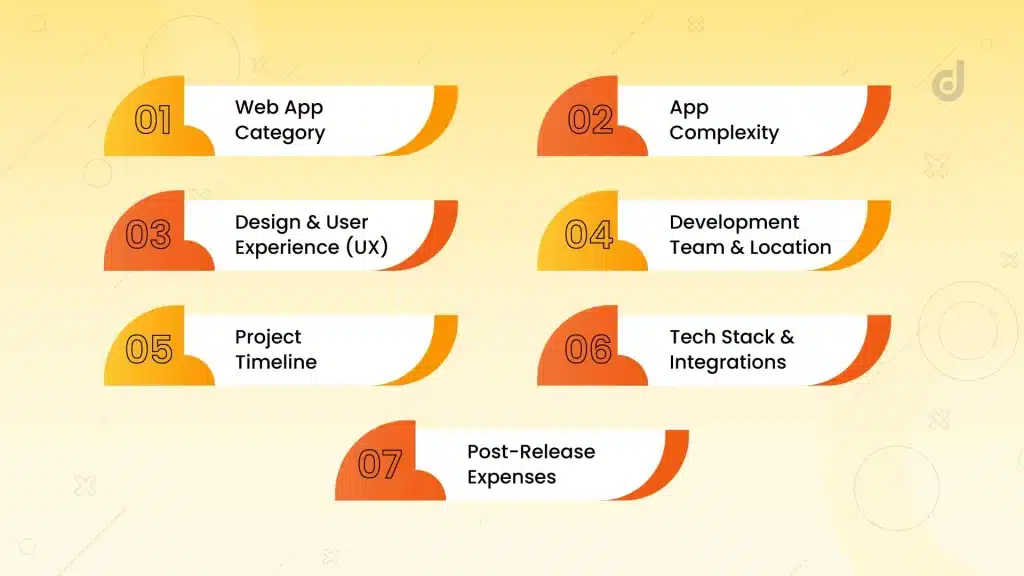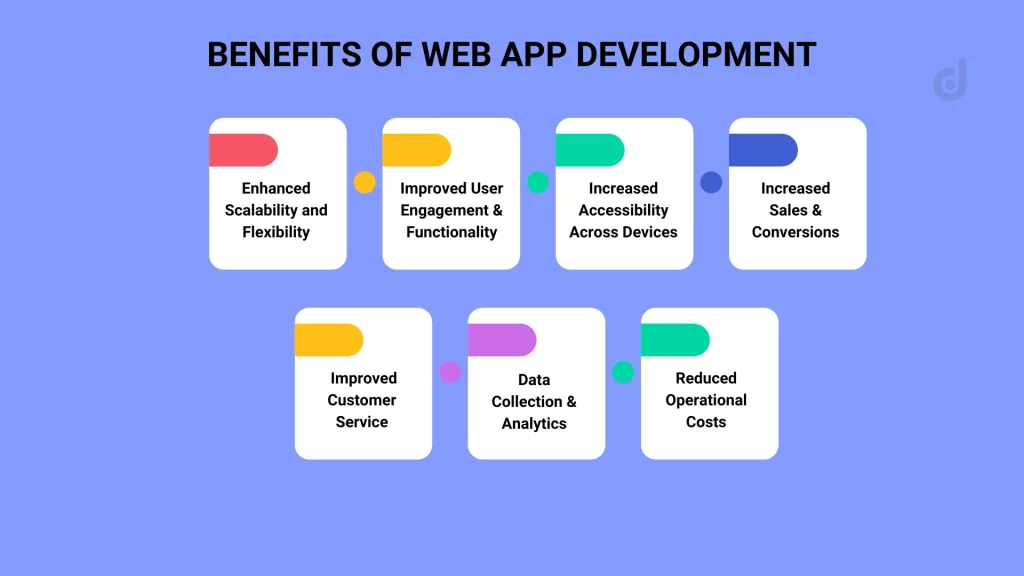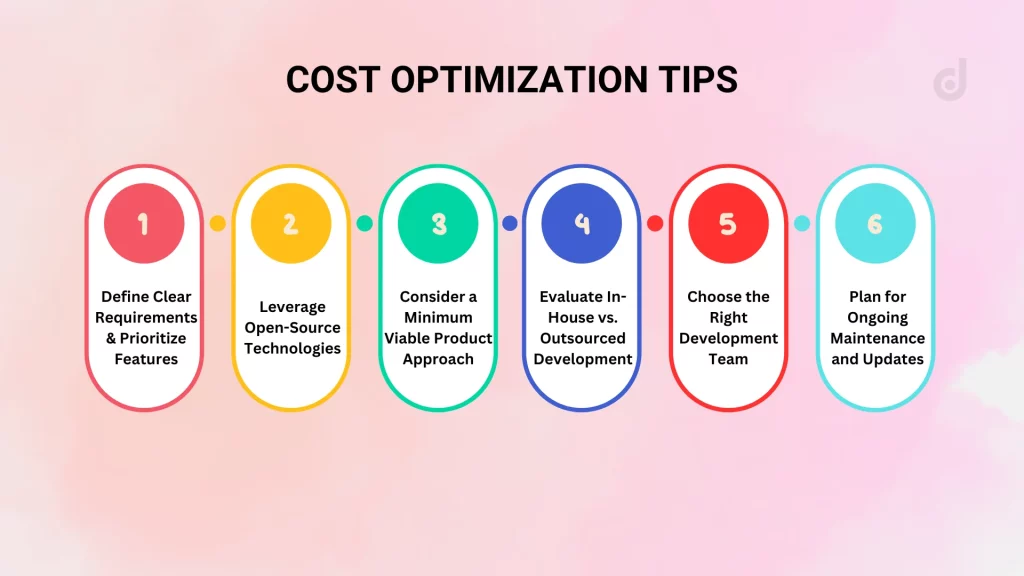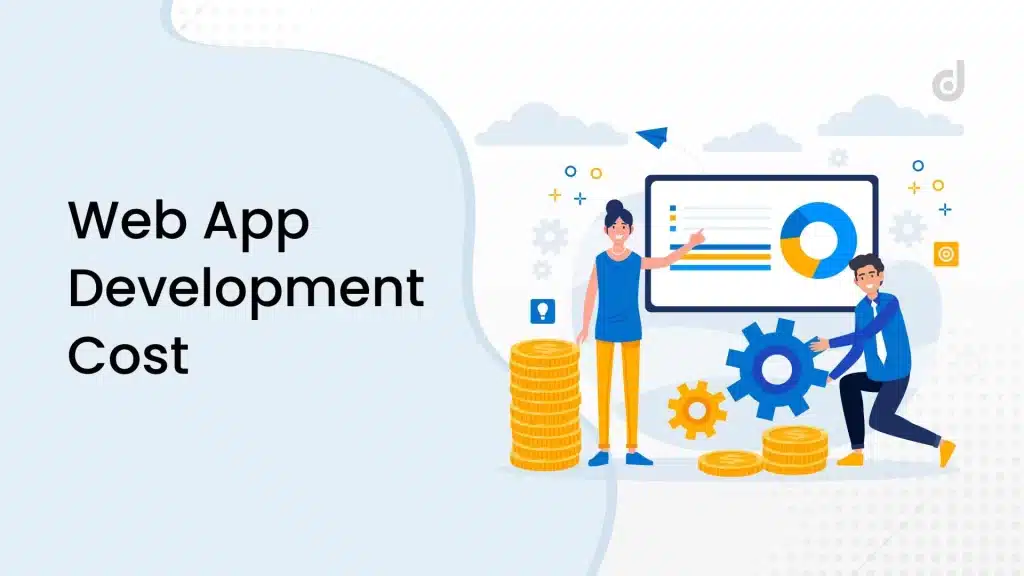The digital landscape is evolving at a breakneck pace. Businesses are increasingly turning to web applications (web apps) to enhance user engagement, streamline operations, and unlock new revenue streams. But a common question lingers: how much does it cost to develop a web application in 2024?
According to a recent Statista report, the revenue in the Application Development Software market is expected to show an annual growth rate (CAGR 2024-2028) of 6.87%, resulting in a market volume of US$234.70bn by 2028. This phenomenal growth reflects the surging demand for custom web apps that cater to specific business needs and deliver exceptional user experiences.
While the potential benefits are undeniable, navigating the world of web app development costs can be a challenge. This blog post aims to demystify the cost factors involved, providing valuable insights to help you make informed decisions. We’ll delve into the various elements that influence web application development costs and explore strategies to optimize your budget for a successful web app launch.
What is a Web App?
Unlike a static website that simply displays information, a web application is an interactive software program that you access through your web browser. Think of it as an application you use on your phone or computer, but delivered conveniently through the internet. Popular examples include Gmail, online banking platforms, social media apps you access on your desktop, and even many online shopping platforms.
Web apps offer a dynamic and engaging user experience compared to traditional websites. They allow you to perform tasks, manage data, and interact with features in real-time, all within your web browser. This interactivity and advanced functionality are what make web apps so valuable for businesses looking to enhance their online presence and connect with users on a deeper level.
What Factors Affect the Web Application Development Costs?
The world of web apps is vast and diverse. When considering web application development, it’s crucial to understand the different factors and how they might impact your budget. Here’s a breakdown of the factors that influence the cost of web application development:

1. Web App Category
When considering web app development, it’s important to understand the different categories of web apps. Each category has its unique features and functionalities, which can impact the overall development effort and cost. Here’s a breakdown of the three most common web app categories:
1. Single Page Applications (SPAs)
These web apps load a single HTML page initially and dynamically update content based on user interaction. Single Page Applications are known for their fast loading times and smooth user experience, but their development complexity can vary depending on the level of interactivity and features required. This can influence the web application development cost.
Popular examples include Gmail and many social media platforms.
2. Multi-Page Applications (MPAs)
These web apps consist of multiple HTML pages, each designed for a specific function. Traditional websites often fall under this category. Multi-Page Applications offer a more structured approach and might be easier to navigate for some users. Development costs for MPAs can be more predictable compared to SPAs, especially for less complex applications
E-commerce websites with product listings and separate checkout pages are a classic example.
3. Progressive Web Applications (PWAs)
PWAs offer a unique blend of web and native app functionalities. They can be accessed through a web browser but can also be installed on a user’s device for offline access and push notifications. While PWAs offer advantages like improved user engagement, their development might involve additional considerations compared to standard web apps, potentially impacting the progressive web app development cost.
2. App Complexity
Within each web app category (SPA, MPA, PWA), the single most significant factor impacting web app development costs is undoubtedly its complexity. Here’s how app complexity translates to development effort and cost:
1. Simple Web Apps
These apps have basic functionalities and a user-friendly interface. The development process for such apps is relatively straightforward, leading to a lower web application development price.
Think of a simple landing page with contact forms or a basic portfolio website.
2. Moderately Complex Web Apps
These apps incorporate more features and functionalities, such as user accounts, login systems, and basic data management. The development time and cost increase compared to simple apps due to the added functionalities.
E-commerce websites with product filtering and shopping carts fall under this category.
3. Highly Complex Web Apps
These apps are feature-rich and often involve complex back-end processes, real-time data interactions, or integrations with third-party services. The development of such apps requires a high level of expertise and time, leading to a higher web application development cost.
Social media platforms with advanced news feeds, recommendation algorithms, and messaging functionalities are prime examples.
3. Design & User Experience (UX)
Beyond app complexity, design and user experience (UX) play a crucial role in shaping the success and overall appeal of your web app. While a well-designed and intuitive UX can significantly enhance user engagement and brand perception, it also factors into web application development costs.
Here’s how design and UX influence development costs:
1. User Interface (UI) Design
A visually appealing and user-friendly interface is essential for a positive user experience. Creating custom UI elements, interactive features, and animations can add to the development time and potentially increase the web application development price. However, a well-designed UI can also lead to a higher user retention rate and improved conversion rates, ultimately boosting your return on investment (ROI).
2. UX Design
This focuses on the overall user journey within your web app. Creating a seamless and intuitive flow for tasks and functionalities requires careful planning and user research. While good UX design can be achieved with basic layouts, complex interactions or user journeys might necessitate additional development efforts, impacting the cost for web application development.
3. Custom Design Elements
Unique design elements like custom icons, illustrations, or animations can significantly enhance the look and feel of your web app. However, creating these elements from scratch adds to the development workload and can influence the web app development cost.
4. Development Team & Location
The expertise and experience of your development team play a significant role in determining web application development costs. Here’s a breakdown of some factors to consider:
1. Developer Rates
Developer rates can vary depending on their skill level, experience, and location. Generally, more experienced developers with specialized skills command a higher hourly or project rate. This can influence the overall cost for web application development.
2. Team Size
The complexity of your web app will determine the size and composition of your development team. Simple apps might require a smaller team of front-end and back-end developers, while complex apps might necessitate additional specialists like UI/UX designers, security experts, and quality assurance testers. A larger team translates to higher overall costs, but it also ensures that all aspects of development are addressed effectively.
3. In-House
Developing your web app in-house allows you to maintain greater control over the project. However, building an in-house team requires significant upfront investment in hiring, training, and infrastructure.
4. Outsourced Development
Outsourcing development to a reputable agency can offer cost-efficiency, access to a wider talent pool, and potentially a faster development timeline. However, it’s crucial to choose an agency with a strong track record and clear communication channels.
5. Freelancers
Hiring freelance web developers can be a cost-effective option for smaller projects. However, finding qualified freelancers and managing project scope effectively can be challenging. Additionally, freelancers might lack the team structure and support systems offered by agencies.
6. Location
Developer rates can vary significantly depending on the geographical location. While outsourcing to regions like Asia with lower development costs might seem appealing, factors like time zone differences, communication barriers, and potential quality control concerns can arise. Finding a development team that aligns with your budget, expertise needs, and communication preferences is vital.
5. Project Timeline
In the world of web development, time truly equals money. The duration of your project, often referred to as the project timeline, significantly impacts web application development price. Here’s why:
1. Development Hours
The complexity of your app directly affects the number of development hours required. More intricate features and functionalities naturally translate to a longer development time. This extended timeline leads to increased development costs, as developers’ hourly rates or project fees accumulate.
2. Iterations and Refinements
The development process often involves iterative cycles where features are tested, refined, and potentially rebuilt based on user feedback. While crucial for a successful final product, these iterations can add to the overall project timeline and consequently, the cost for web application development.
3. Development Methodology
The chosen development methodology can also influence the timeline and cost. Agile methodologies, which break down development into smaller sprints, can promote faster iteration cycles and potentially lead to cost savings in the long run compared to traditional waterfall methodologies.
It’s important to establish realistic timelines during the planning phase to manage expectations and web application development cost estimation. While a rushed timeline might seem cost-effective initially, it can lead to cutting corners or sacrificing quality, potentially resulting in the need for costly rework later on.
6. Tech Stack & Integrations
The technology stack (tech stack) you choose for your web app development forms the foundation of its functionality and performance. However, the specific technologies you utilize can also influence web application development costs. Here’s a breakdown of how tech stack choices impact your budget:
1. Front-End vs. Back-End Development
Web apps require both front-end and back-end development. Front-end technologies like HTML, CSS, and JavaScript determine what users see and interact with. Back-end technologies like programming languages and frameworks power the core functionalities and data processing behind the scenes. Choosing well-established front-end and back-end technologies can streamline development and potentially reduce costs compared to working with less common options that require specialized expertise.
2. Third-Party Integrations
Integrating with third-party services like payment gateways, social media platforms, or analytics tools can enhance your web app’s functionality. However, these integrations can introduce additional development effort and potentially require licensing fees, impacting the web application development cost estimation.
3. Open-Source vs. Proprietary Technologie
Utilizing open-source technologies can be a cost-effective approach, as you don’t incur licensing fees. However, open-source solutions might require additional development time for customization or integration compared to pre-built, proprietary options.
The key lies in striking a balance between functionality, cost, and long-term maintainability. A skilled development team can help you choose the right tech stack for your project, considering both your budget and desired features.
7. Post-Release Expenses
While the development phase is crucial, it’s important to consider ongoing expenses that might factor into your web application development cost breakdown. Here’s a glimpse into some post-release considerations:
1. Hosting
Your web app needs a reliable hosting platform to be accessible to users online. Hosting costs can vary depending on the traffic volume, storage requirements, and chosen hosting plan.
2. Maintenance and Updates
Web apps require ongoing maintenance to address bugs, security vulnerabilities, and ensure compatibility with updated software or browsers. Additionally, new features or functionalities might necessitate future development efforts. Budgeting for ongoing maintenance ensures a smooth user experience and protects your investment.
3. Scalability
As your user base or data volume grows, your web app might require additional resources to handle the increased load. Planning for scalability from the outset and budgeting for potential upgrades can minimize disruptions and ensure a positive user experience in the future.
Average Web Application Development Costs
Understanding the average web application development costs can be a helpful starting point for your budgeting process. However, it’s crucial to remember that these are estimates, and the actual cost can vary significantly depending on the specific features, design complexity, development time, and developer rates. Here’s a breakdown of average costs for different web app categories:
Simple Web Apps
- Features: Limited functionalities, static content, basic forms.
- Development Time: Short (weeks to a few months).
- Developer Rates: Can vary based on location and experience, but generally on the lower end.
- Average Cost Range: $5,000 – $15,000
- Example: Landing Pages, Basic Portfolios
Moderately Complex Web Apps
- Features: User accounts, login systems, product listings with filtering, basic data management.
- Development Time: 1-3 months.
- Developer Rates: May involve a mix of front-end and back-end developers with varying rates.
- Average Cost Range: $15,000 – $50,000+
- Example: E-commerce Websites with Shopping Carts
Highly Complex Web Apps
- Features: Advanced functionalities, complex user interactions, real-time data processing, integrations with third-party services.
- Development Time: 6+ months.
- Developer Rates: Requires a team of highly skilled developers with specialized expertise, potentially commanding higher rates.
- Average Cost Range: $50,000+ (highly variable depending on complexity)
- Example: Social Media Platforms, Real-Time Data Apps
Progressive Web Apps (PWAs):
- Development costs for PWAs can vary depending on the level of complexity and desired functionalities. They might fall within the range of moderately complex or highly complex web apps depending on the specific features. For example, a simple PWA might be similar in cost to a moderately complex web app, while a feature-rich PWA with offline functionality and push notifications could approach the costs of a highly complex web app.
Important Note: These are just ballpark figures, and the actual cost for your web app can differ significantly. It’s essential to work with a reputable development agency to get a more accurate web app development cost based on your specific project requirements.
Benefits of Web Application Development for Businesses
We’ve established that web applications offer a dynamic and feature-rich alternative to traditional websites. But the true value proposition lies in the tangible benefits they deliver to businesses across various industries. Let’s explore some key advantages of web application development for businesses:

1. Enhanced Scalability and Flexibility:
Imagine a website that struggles to handle a sudden surge in traffic during a promotional campaign. Web apps eliminate this concern. They can effortlessly scale to accommodate growing user bases and data volumes. This allows businesses to:
- Expand their reach: A scalable web app ensures smooth operation as your customer base or user traffic increases.
- Embrace new opportunities: The inherent flexibility of web apps allows for seamless integration with new technologies or third-party services as your business evolves.
- Future-proof their investment: By building a scalable web app from the outset, businesses avoid the need for costly website rebuilds or major infrastructure upgrades in the future.
For instance, a food delivery app can experience significant spikes in orders during peak hours. A web app ensures smooth operation and a seamless user experience even during these high-traffic periods.
2. Improved User Engagement and Functionality:
Web apps go beyond simply displaying information. They offer interactive features and functionalities that keep users engaged and coming back for more. This can translate to:
- Increased conversions: Engaging features and a user-friendly interface can guide users through the sales funnel and encourage them to take desired actions.
- Enhanced customer satisfaction: A web app that empowers users with self-service functionalities (e.g., account management, order tracking) improves customer satisfaction and reduces reliance on support teams.
- Boosted brand loyalty: A well-designed and engaging web app can foster brand loyalty by providing users with a valuable and interactive experience.
For example, a fitness center can develop a web app that allows members to book classes, track workouts, and connect with trainers. This level of functionality keeps users engaged and motivates them to continue their fitness journey with the gym.
3. Increased Accessibility Across Devices:
In today’s mobile-first world, accessibility is paramount. Web apps are accessible from any device with a web browser, eliminating the need for users to download and manage separate mobile applications. This translates to:
- Wider reach: A web app allows you to connect with users on their preferred devices, be it a desktop, smartphone, or tablet. This broadens your potential customer base and increases accessibility.
- Improved user experience: Users can seamlessly transition between devices and continue using the web app without interruption, fostering a smooth and consistent user experience.
- Reduced development costs: Developing a single web app accessible across devices can be more
An e-commerce store with a web app allows customers to browse products, add items to carts, and complete purchases seamlessly on their phones or desktops. This device-agnostic approach removes barriers to purchase and improves the overall customer journey.
4. Increased Sales and Conversions
Web apps offer a dynamic and interactive experience compared to static websites. This can lead to:
- Improved product visualization: Web apps can showcase products with interactive features like 360-degree views, virtual try-on options, or detailed product specifications.
- Streamlined checkout processes: User-friendly interfaces and one-click purchase options can encourage users to complete transactions quickly and efficiently.
- Personalized recommendations: Web apps can leverage user data to recommend products or services relevant to their interests and purchase history, increasing the likelihood of conversions.
For example, a furniture store can develop a web app that allows customers to virtually place furniture pieces within their own homes using augmented reality. This interactive experience can significantly boost sales and conversions.
5. Improved Customer Service
Web apps can transform customer service by offering:
- 24/7 availability: Self-service features like FAQs, knowledge bases, or chatbots can answer user queries anytime, even outside of business hours.
- Reduced support costs: By empowering users to find solutions independently, web apps can reduce the burden on customer support teams.
- Improved customer satisfaction: Offering multiple avenues for customer support through web apps demonstrates responsiveness and improves overall customer satisfaction.
An airline company can develop a web app that allows passengers to check-in for flights, manage bookings, or track their luggage status in real-time. This not only empowers customers but also frees up support staff to handle more complex inquiries.
6. Data Collection and Analytics
Web apps provide valuable data insights into user behavior and preferences. Businesses can leverage this data to:
- Personalize marketing campaigns: By understanding user behavior and interests, businesses can tailor marketing campaigns for maximum impact.
- Identify trends and optimize features: Web app analytics can reveal areas for improvement or highlight popular features, allowing businesses to make data-driven decisions.
- Gain a competitive edge: Insights gleaned from user data can help businesses understand market trends and develop strategies to stay ahead of the competition.
A music streaming service can utilize web app data to analyze user listening habits and recommend new music tailored to their tastes. This data-driven approach can significantly improve user engagement and retention.
7. Reduced Operational Costs
Web apps can automate repetitive tasks and streamline internal workflows, leading to:
- Increased efficiency: Automating tasks like scheduling, data entry, or reporting can free up employee time to focus on higher-level tasks.
- Reduced human error: Automated processes minimize the risk of errors associated with manual data entry.
- Improved resource allocation: By streamlining operations, businesses can optimize resource allocation and potentially reduce overall operational costs.
A manufacturing company can develop a web app for managing inventory, tracking production processes, or scheduling deliveries. This automation can lead to significant cost savings and improved operational efficiency.
By leveraging the diverse benefits of web application development, businesses can gain a competitive edge, enhance customer experience, and unlock new avenues for growth.
Tips to Reduce the Web App Development Cost
While the potential benefits of web applications are undeniable, navigating the world of web application development costs can feel overwhelming. Here are some practical tips to help you optimize your budget and get the most out of your investment:

1. Define Clear Requirements and Prioritize Features:
- Before diving into development, take time to clearly define the functionalities and features your web app absolutely needs.
- Prioritize these essential features and consider phasing in less critical functionalities in future iterations.
- A well-defined scope of work with prioritized features allows for a more accurate web application development cost estimation.
2. Leverage Open-Source Technologies When Feasible:
- Explore the vast landscape of open-source technologies that can provide the functionalities you need without hefty licensing fees.
- Open-source options can significantly reduce development costs compared to proprietary solutions.
- However, ensure you have the resources or expertise to manage and maintain open-source components over the long term.
3. Consider a Minimum Viable Product (MVP) Approach:
- Develop a Minimum Viable Product (MVP) with the core functionalities to launch your web app quickly and gather real-world user feedback.
- This allows you to test the market, validate your concept, and refine features based on user data before investing in a full-fledged product.
- The MVP approach helps manage web application development costs upfront while providing valuable insights for future development.
4. Evaluate In-House vs. Outsourced Development:
- Carefully consider the advantages and disadvantages of building your web app in-house or outsourcing development to a reputable agency.
- In-house development offers greater control but requires significant upfront investment in hiring and infrastructure.
- Outsourcing can be more cost-effective and provide access to a wider talent pool, but clear communication and project management are crucial.
5. Choose the Right Development Team:
- Partnering with an experienced and skilled development team is paramount for cost-effective web app development.
- Look for a team with expertise in relevant technologies and a proven track record of delivering successful web applications.
- While cost is a factor, consider the value a skilled team brings in terms of efficiency, quality, and long-term maintainability.
6. Plan for Ongoing Maintenance and Updates:
- Factor in the cost of ongoing maintenance and updates when considering web application development costs.
- Web apps require regular updates to address bugs, security vulnerabilities, and ensure compatibility with evolving technologies.
- Budgeting for maintenance from the outset ensures a smooth user experience and protects your investment in the long run.
By following these tips and adopting a strategic approach, you can optimize web application development costs and develop a successful web app that delivers value for your business.
Conclusion
The world of web application development is brimming with possibilities. By understanding the factors influencing web application development costs and the immense value web apps can deliver, you’re well on your way to making informed decisions.
The key lies in defining your requirements clearly, prioritizing features strategically, and choosing the right development partner. With a well-planned approach, you can develop a powerful web app that exceeds expectations and propels your business forward.
Are you ready to leverage the power of web applications to transform your business?
Digimonk Solutions is a leading web application development company with a proven track record of delivering innovative and cost-effective solutions. Our team of skilled developers can help you navigate the entire development process, from concept to launch and beyond.
Contact Digimonk Solutions today for a free consultation and let’s discuss how we can craft a web application that perfectly aligns with your business goals and budget.

